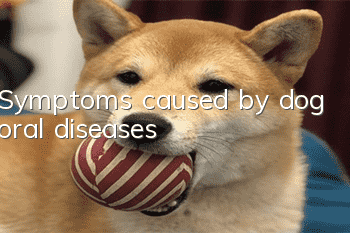Symptoms caused by dog oral diseases

Symptoms caused by oral diseases in dogs:
1. Thrombosis: A condition in which thrombus or blood clots appear in blood vessels, causing blood vessel obstruction. It is one of the causes of sudden death in dogs. The mortality rate is extremely high and very scary! Thrombosis can damage the tissues that receive oxygen and nutrients from the blood vessels. The continued development of the thrombus will also cause necrosis of the heart and brain tissue, and may also cause hyperpnea. Difficulty, whole body trembling, and inability to stand.
2. Impairment of heart function: It hinders the normal operation of the heart and body, and over several years will gradually lead to diseases such as low heart function. This situation often occurs in older dogs who tend to accumulate tartar.
3. Impairment of kidney function: It hinders the normal operation of the kidneys and the body, and over several years will gradually lead to diseases such as low kidney function. This situation often occurs in older dogs who tend to accumulate tartar.
Since the roots of the dog's teeth are located near the nose and eyes, once suppuration occurs, pus may flow from the nose and eyes, and there may even be scratch-like wounds under the eyes. Once such a situation occurs, the bacteria that cause periodontal disease may enter the organs in the dog's body along with the blood, causing systemic infection and even death.
Types of oral diseases in dogs:
1. Dental calculus: Dental calculus synthesized from food residues and bacteria is the culprit of bad breath in dogs.
2. Periodontitis: Periodontitis involves acute or chronic inflammation of the gums and alveolar bone tissue around the teeth. If not treated in time, it can cause gum recession and loose teeth.
3. Dental plaque: If parents have never taken care of their dog’s teeth, there is likely to be plaque caused by food residue and bacteria on the dog’s teeth.
4. Tooth decay: Remaining food residue and unbalanced nutrition can cause tooth decay.
5. Gingivitis: Gingivitis is a precursor to periodontal disease. It mostly occurs at the junction of the gums and teeth, which is also called the gingival sulcus.
6. Broken teeth: Dogs break teeth because dogs naturally like to chew things. During the process of chewing hard things, the teeth will be worn or even broken.
- What causes a dog’s eyes to be red?
- The dog suddenly growled and became clingy
- What is good for dogs to eat for their hair?
- Ten rules for properly raising dogs
- The Importance of Checking Your Dog’s Anal Glands
- How to keep an adult shepherd dog in good obedient habits, shepherd dog training!
- How to train a young Bichon Frize? Tips on training a 2-month-old Bichon Frize!
- Popular dogs may not be suitable for you to keep! Take stock of the pros and cons of popular dog breeds
- Does a dog have a nosebleed because he is angry? In fact, it is a sign of serious illness. If the owner does not deal with it in time, it will harm the dog.
- Dog first aid methods must be learned by poop shovelers!



